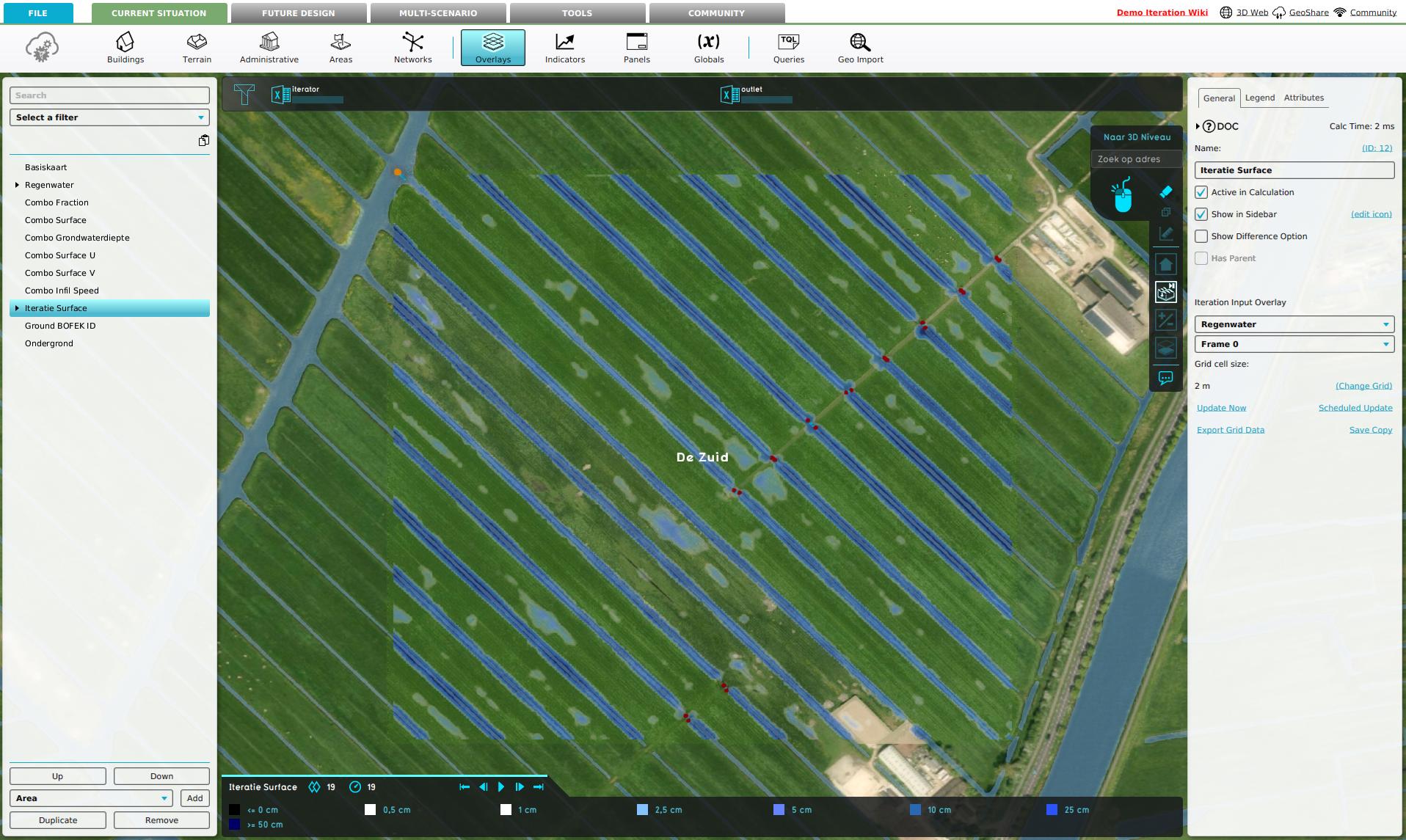Demo Iteration Project: Difference between revisions
No edit summary |
|||
| Line 1: | Line 1: | ||
{{stub|todo= | |||
* Demo Project must be in English | |||
}} | |||
{{demo project summary | {{demo project summary | ||
| title=Demo Iteration | | title=Demo Iteration | ||
Revision as of 09:15, 4 December 2024
- Demo Project must be in English

The Demo Iteration project is available for all users and can be found in the main menu under Edit projects. This project does not count towards your license.
This project is intended for hydrologists and other water experts.
This project showcases the rainfall overlay in a iteration mode.
The demo show the iteration functionality that can be used to adjust the ground infiltration speed using a combo formula.
Calculations using the Iteration option
The demo project simulates a Dutch polder to demonstrate how rainfall infiltration can be modeled using the iteration option.
We want the speed at which rainwater infiltrates to depend on the degree of saturation of the soil. By dividing the rain event into several iteration steps, we can adjust the infiltration rate for each iteration step based on the degree of saturation of the soil. In this way, infiltration can be calculated in a more realistic way.
The purpose of this demo project is to clarify how an iterative calculation can be made. In this case, the infiltration of water during and after a precipitation event was chosen. However, on the basis of this demo project, it should also be possible to calculate other calculations iteratively.
Setup of the Demo Project
The demo project consists of a number of components that are essential for this calculation.
Combo Overlays
Before we create the Rainfall event, a number of overlays are created that serve as input for the various iteration steps. At the end of each iteration the combo overlay is updated an serves as the input for the next iteration step. We'll go through the different combo overlays.
Combo Surface U and Combo Surface V
These overlays say something about the initial velocity of the surface water in x and y directions. When water flows down a slope, we want to use the speed at which the water flows at the end of an iteration step as the initial speed at the next iteration step. The input grid is the result of the last calculation. In the formula of this combo overlay, you can see that the formula is aimed at making sure that it computes with the data from the previous time step, unless the previous iteration step was step 0. In that case, 0 is used.
Make sure to check the box "previous" to make sure the Combo Overlay uses the U and V of the previous itertationstep.
The formula in the combo overlay should in this case read: IF(EQ(ITERATION, 0), 0, A)
Combo Fraction and Combo Groundwater Depth
The purpose of the combo overlay Combo Fraction and the combo Groundwater Depth is to set the input from the previous iteration step to be used, unless the previous iteration step was step 0. In that case, a global value is used. The global DEFAULT_FRACTION is used for the saturation percentage, and the global DEFAULT_TABLE is used for the groundwater level.
The formula in the combo overlay Combo Fraction should in this case read:
IF(EQ(ITERATION, 0), GLOBAL_DEFAULT_FRACTION, IF(EQ(A, NO_DATA), GLOBAL_DEFAULT_FRACTION, A))
The formula in the combo overlay Combo Groundwater Depth should in this case read:
IF(EQ(ITERATION, 0), GLOBAL_DEFAULT_TABLE, A)
Combo Surface
The combo Surface gives the last value of the waterlevel on the surface and is input for the next iteration step. If there is no previous iteration step, the value should be 0. Make sure to check the box "previous" to make sure the Combo Overlay uses the values of the previous itertationstep.
The formula in the combo overlay Combo Fraction should in this case read:
IF(EQ(ITERATION, 0), 0, A)
Combo Infiltration Speed
The purpose of the Combo Overlay Combo Infiltration Speed is to set the correct formula depending on the saturation of the soil. This example uses the overlay Ground BOFEK ID to determine the type of soil.
The formula is entirely hypothetical and only serves to make it clear that, for each iteration step, a value is chosen based on the degree of saturation.
The formula in the combo overlay reads in this case:
MAX(0, SUB(GLOBAL_DEFAULT_INFIL, SWITCH(B, 0, 1004, MUL(10, SUB(A, GLOBAL_DEFAULT_FRACTION)), 1006, MUL(5, SUB(A, GLOBAL_DEFAULT_FRACTION)))))
Rainfall Overlay
When setting the rainfall overlay, the default settings can be used. The exceptions are described below.
Rain Event Duration: Here the the total duration of the calculation is specified. Later this is divided into different iterationsteps.
Water System – Water Level: Here the initial water level and the U and V flow are set. Use the option "Advanced: Select Grid Overaly to set initial water level and also flow UV".
The water level is set based on a specific overlay, which is the combo overaly Surface. Similarly, the y and x speed from the combo overlay is used as initial input.
Groundwater: Initialize the groundwater level using the Groundwater Depth combo overlay.
Unsaturated Zone: Initialize saturation and storage percentages per grid cell using the Fraction combo overlay.
Generated Output Overlays:
- Surface Last Value
- Rain
- Ground Last Value
- Ground Watertable
- Ground Last Unsaturated Storage
- Ground Last Unsaturated Fraction
- Surface Last U
- Surface Last V
- The number of timeframes is set to 1.
Iteration Collector
The iteration collector is a type of overlay. It shows the results of each iteration step. An iteration collector needs an input overlay, in this case it is the Rainfall overlay. Of each iteration step one timeframes wil be saved.
An attribute of the iteration overlay is the modulus. The modulus determines how many iterations you store. By default, this is set to 1. This means that only one (the last) result of each iteration step is saved and used as a timeframe in the iteration collector. When the modulus is set to 1, every iteration is stored. When you set the modulus to 2, half of the iteration values are stored.
Indicator
Het doel van de indicator is het instellen van de start en eind tijd van de iteratiestap van de regenwateroverlay. Om dit te bewerkstelligen worden een aantal queries uitgevoerd . Allereerst wordt bepaald hoeveel iteratiestappen zijn gekozen en hoe lang de totale simulatietijd is ingesteld. Dit gebeurd met de query SELECT_ITERATIONS_WHERE en SELECT_ATTRIBUUT_WHERE_NAME_IS_RAIN_M_AND_OVERLAY_IS_10_AND_RELATION_IS_WEATHER_AND_INDEX_IS_2.
Met de querys UPDATE_OVERLAY_PARTIAL_START_SEC_WHERE_OVERLAY_IS_3 en UPDATE_OVERLAY_PARTIAL_END_SEC_WHERE_OVERLAY_IS_3 worden respectievelijk de begin en eindtijd van de volgende iteratiestap bijgesteld. Om te weten wat de volgende iteratiestap is wordt de query SELECT_ITERATION_WHERE uitgevoerd.
Fraction Start en Fraction End geven de start en end als fractie. Bij Start en End wordt dit uitgedrukt in seconden door deze fractie te vermenigvuldigen met de totale simulatietijd.
Number of Iterations
The number of iterations can be set via the calculation panel. Here you find the option iteration where you can set the number of iterations. This is set to 1 by default.
Exploring the results
To view the results of the calculation, the Iteration can be played everywhere. The following results can be seen here:
- Water on ground level in meters
- Iteration Fraction: The fraction of the total water storage capacity of the unsaturated zone that is filled with water in meters
- Iteration Storage: The amount of water in the unsaturated zone in meters
- Iteration Infil Speed: The infiltration speed in meters per day
- Iteration Rain: The total amount of rainfall up to that point in the simulation in meters.
- Iteration grondtable: The groundwater level in m + datum.
When the iteration ifil speed is viewed, it becomes clear that the two different soil types (BOFEK IDs) give a different result in the infiltration speed.
Notes and Limitations
Debugging cannot be downloaded per iteration but can be saved for each iteration. Specific updates (e.g., updating attributes for certain building types in iteration 5) can be executed using the API and indicator but not through TQL for non-initial iterations.
Effect of Iterations on Calculation Accuracy
When calculating a precipitation event, there may be a difference between a standard calculation and an iterative calculation, even if they use the same rainfall overlay. This is due to the way data is processed during an iterative calculation.
In a standard calculation, the precipitation event is executed in a single step. In an iterative calculation, on the other hand, the event is split into multiple time steps, for example 10. After each iteration step, the data is stored and prepared for the next step. Rounding occurs during this process, which can affect the accuracy of the results.
The water levels are stored internally in a 64-bit format, which provides high precision with 12 decimal places. However, the results are displayed in a 32-bit format, which has an accuracy of 6 decimal places. In the iterative calculation, the 32-bit result is used. This causes small rounding differences between the results. The more iteration steps there are, the more often this rounding occurs and the larger the deviation can become.
At this point, these differences are considered negligible. If necessary, measures can be taken to solve this problem.
